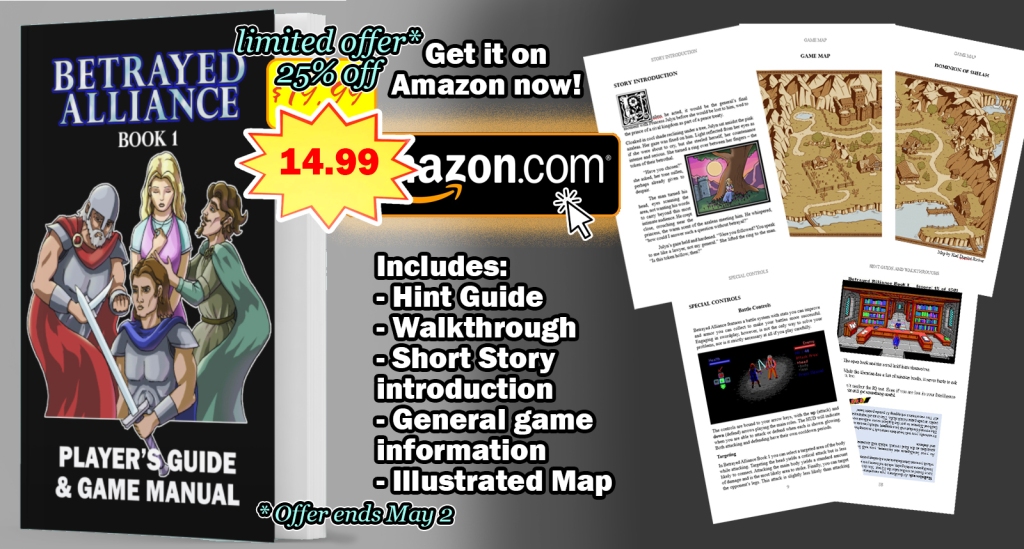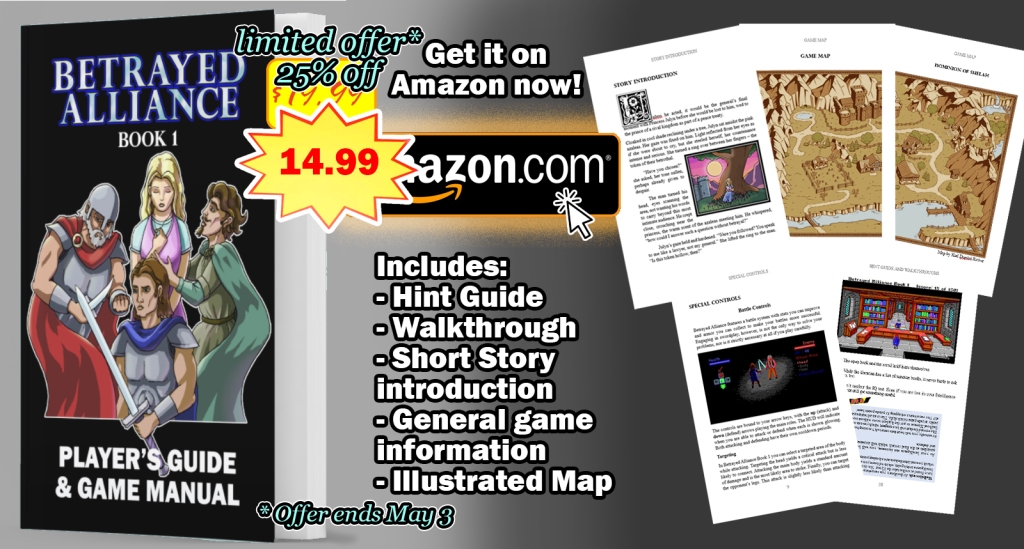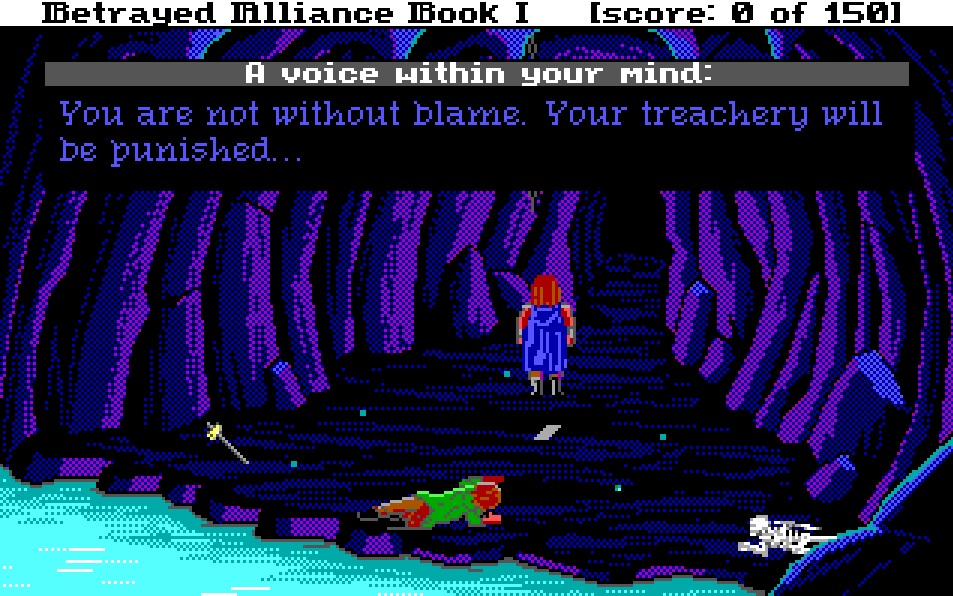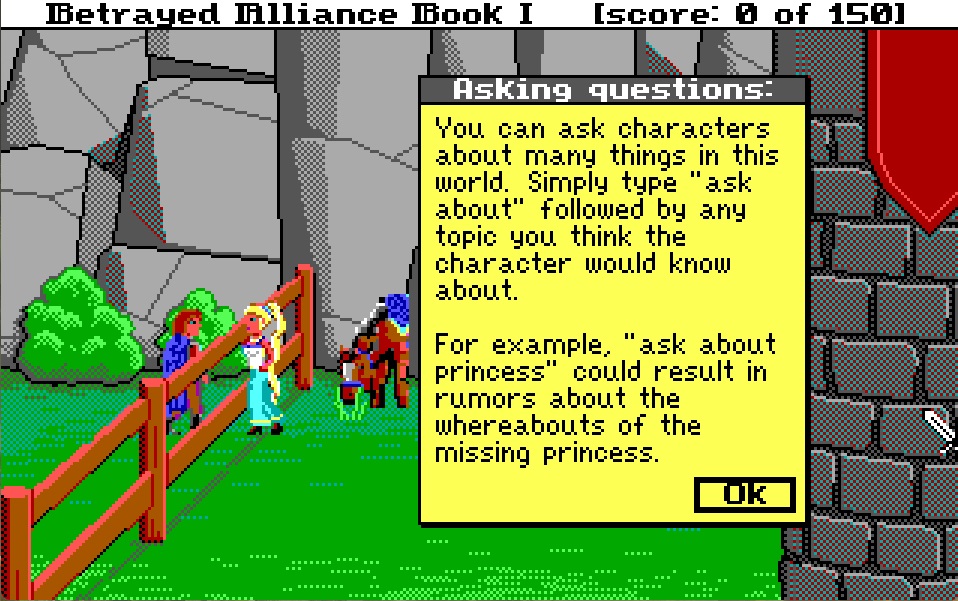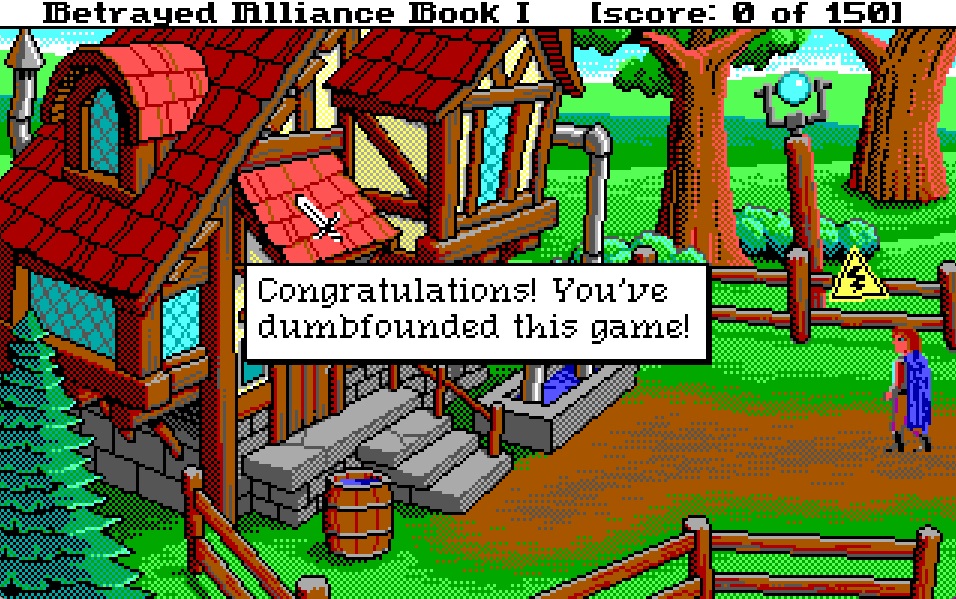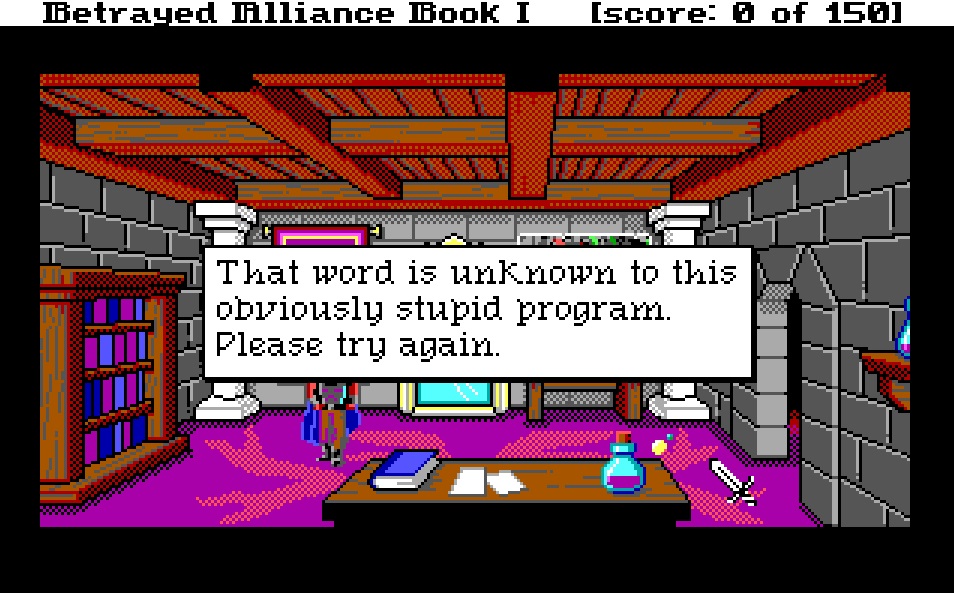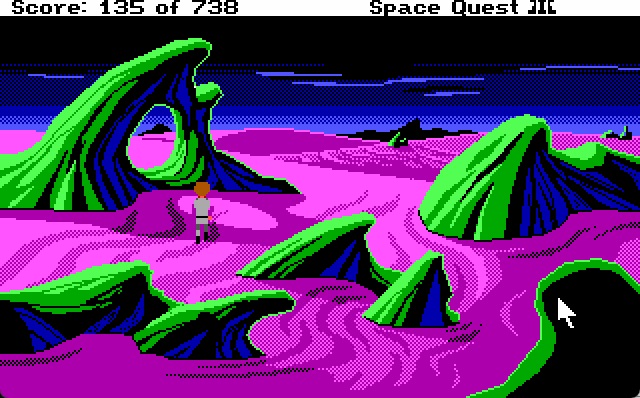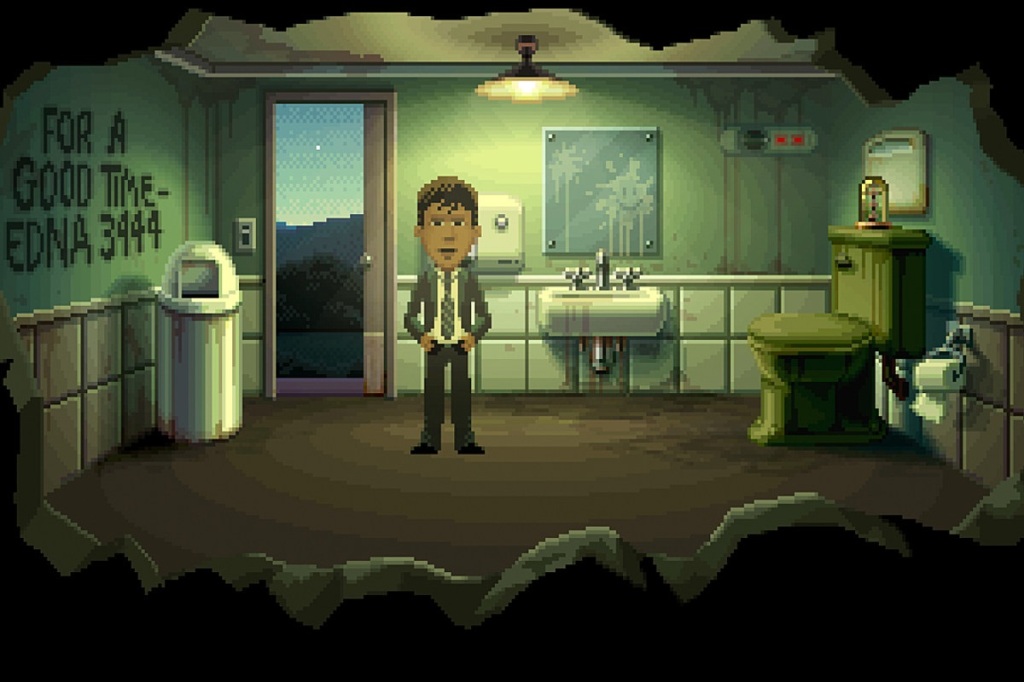“I will never work on this again!” I said to myself.
Have you ever worked on something for so long it evolved into something else? I have! And that thing is “Betrayed Alliance”
Why am I writing something critiquing my own game series a mere 7 days before a release? Mainly I just wanted the information out there, so that people who were confused by the mess of the series, can understand why and how it got that way. And just why has “Book 1” been “released” three times?!
The Lost Demo for Betrayed Alliance
Betrayed Alliance “Book 1” starts in medias res having apparently just escaped from jail. Seems an odd place to start a game, especially since you could just as easily start the game “on the run” from the authorities. The reason for this oddity, which could have been a part of the game itself, is that once upon a time there was a demo for Betrayed Alliance called “Knight’s Quest,” where you play the character from Betrayed Alliance and you do mount a daring escape. That demo, while surely still exists somewhere, now has other plot elements that are not part of Betrayed Alliance.


Now you see what a mess I’ve really made of this whole thing!
There was never intended to be “Books” in this trilogy! It wasn’t supposed to be a trilogy at all! It was just supposed to be one big game. But, due to the fact that by 2013, I had worked on the project for almost seven years – of very sporadic and unfocused time – and completed only the first 1/3 of the game, I thought I would just finish that 1/3, call it “Book 1,” and never touch the damned thing again. After all, in that time, three large life-changes had happened:
- I got a full-time job
- I got married
- I had just had my first child
Silly things like working truly countless hours on a game that probably no one would ever even play, and likely wouldn’t even be good, seemed like a thing of the past. Lot’s of negative self-talk in my old mindset!
Book 1 being released apart from the rest of the game limited its features, especially combat, which would play a bigger role in the entire game, but only plays a small role in the first part. Because of this, combat in Book 1 feels tacked-on and unimportant. I decided to make combat completely optional because it seemed just so unnecessary.
The release of Betrayed Alliance Book 1
Kidney stones, running 5ks, and being a dad for the first time. There was plenty on my plate already in 2013, but just before fall I made an announcement, that I would wrap development on Book 1 of Betrayed Alliance and release it to the small SCICommunity. Six months of crunching and a mad dash of bug fixes and I release on Christmas of 2013, just as a really early trailer had announced.
That was that. I released a free game to the world, but almost no one knew about it, and even less people cared! But I was proud of my little accomplishment, and there were a few people who enjoyed the game and let me know. After a while, I put together a walkthrough at the request of a few people who had gotten stuck, and after a couple of years I patched the game to fix some of the biggest bugs – one of which made the game nearly incompletable!
Six Years of Distance
Every once in a while someone would ask how Book 2 was coming for Betrayed Alliance. And I’d always reply with the same response: “Sorry, I’m not working on it anymore.”

From 2013 to 2019 I had found a new hobby, writing fiction. After I self-published a couple of young adult/middle grade stories, I set out to write something bigger and something a bit deeper. I had an idea for a pirate story featuring mystical islands with a lot more depth than a typical swashbuckling adventure. I set out to write this book year after year, each time ending in shipwreck. In the meantime, every time someone would ask about Betrayed Alliance, a new spark of excitement would ignite within me.


I also caught sight of a little indie project called The Crimson Diamond, by Julia Minamata and was blown away by the beautiful artwork she had created with the same colors and resolution I had been working with. I was greatly inspired by Julia to level up my artwork, which would lead to the creation of new backgrounds for Betrayed Alliance Book 2. In 2019, I had decided I was back on board the ol’ project.
The Attack Plan
At the outset, brimming with new project enthusiasm and stupidity, I thought I would complete both Books 2 and 3 together. After all, I completed Book 1, so I have the experience and know-how to sidestep many of the issues. This idea was short-lived, however, as the reality of the work set in.


So I formulated a new plan, one that would justify the Book division of the game. Each Book would have it’s own unique gameplay focus. Book 2 would feature a two-playable character system and Book 3 would feature a time-based day/night cycle and the ability to revisit the areas of Book 1 with new quests and things to find (in addition to a fully explorable new area of comparable size).
One major concern about the game was its lack of sound support. It was a DOS game, but used a Windows program to play music and sound. This needed to be fixed, but I wasn’t competent enough to solve it. Luckily, I knew someone who was. That’s where Brandon Blume comes into the mix. His knowledge of the hardware and sound drivers are making it possible for Betrayed Alliance to be truly DOS and truly retro in all aspects.
In addition to Brandon Blume, a second talented Canadian also found his way to help on the project. A fellow named Karl Dupéré-Richer. At first, he was eager to create some creatures and goblins for the game, many of which are featured in Book 2. But when the Kickstarter stretch goal of overhauling Book 1’s artwork and music was hit, he offered to help with the recreation of those backgrounds as well. A good 2/3 of the background artwork in Book 1 are now creations by the hand of Karl, who even learned to use SCI Companion, the program used to create the vector-based artwork necessary for these style of games.


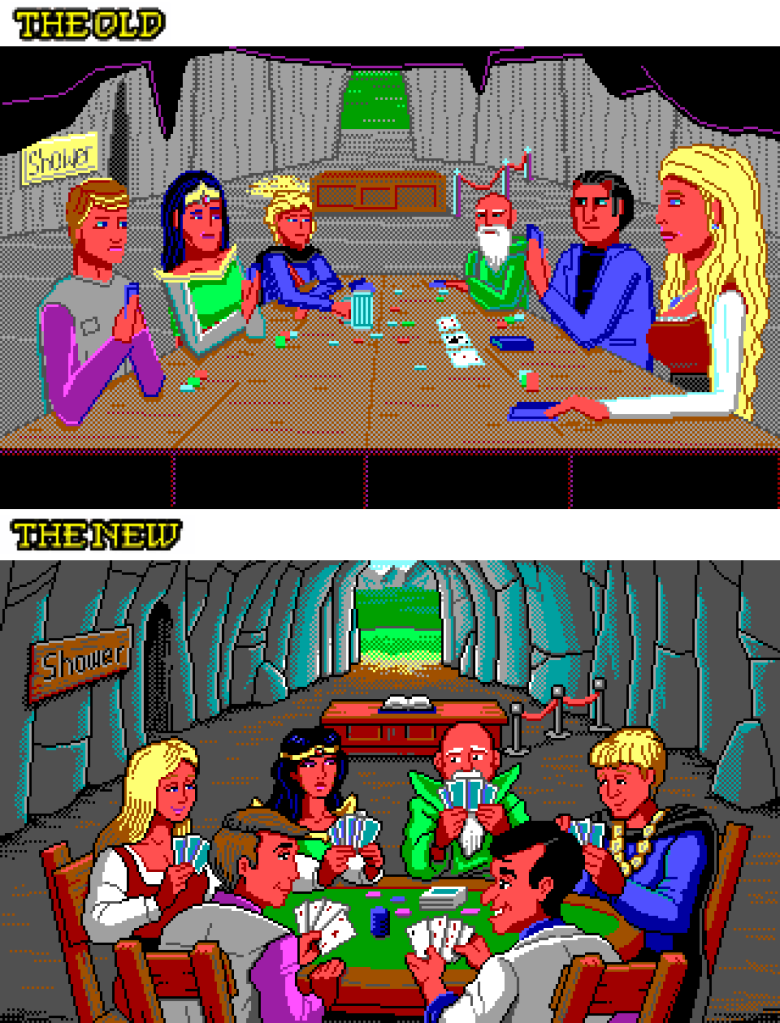
Needless to say there is no comparison between the old artwork and Karl’s updates. It’s like when an artist takes a child’s drawing and makes something intricate and beautiful out of the basic design.
The Third Release?
Yes, it’s true, albeit unfortunate! In 2023, I had released a demo for Betrayed Alliance Book 2 eager to share with the Kickstarter backers and legendary folks who support me on Patreon the fruits of their generosity and the outcome of my work for the last few years.
Then the obvious happened. People downloaded not the demo for Book 2, but rather Book 1, naturally! And while Book 1 has a certain charm to it, at this point I was embarrassed by the artwork, most of which was done over a decade ago at that point. And the fact that there was a game-ending bug that effected a non-zero percentage of runs irked at me. It needed addressing and fast!
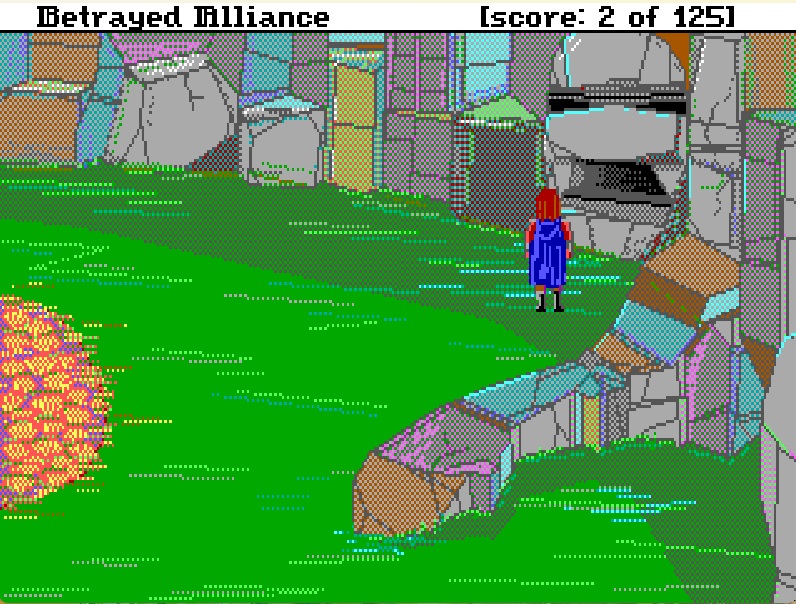


I had released Book 1 in 2013, did a major update in 2019, but the Kickstarter stretch goal to update the artwork and music had not been completed. I became afraid to promote the demo for Book 2 as it would lead people back to Book 1, so I decided to shift focus from Book 2 to completing the Book 1 update, which has been a lot more work than simply switching out backgrounds and music tracks!
Where Things Now Stand
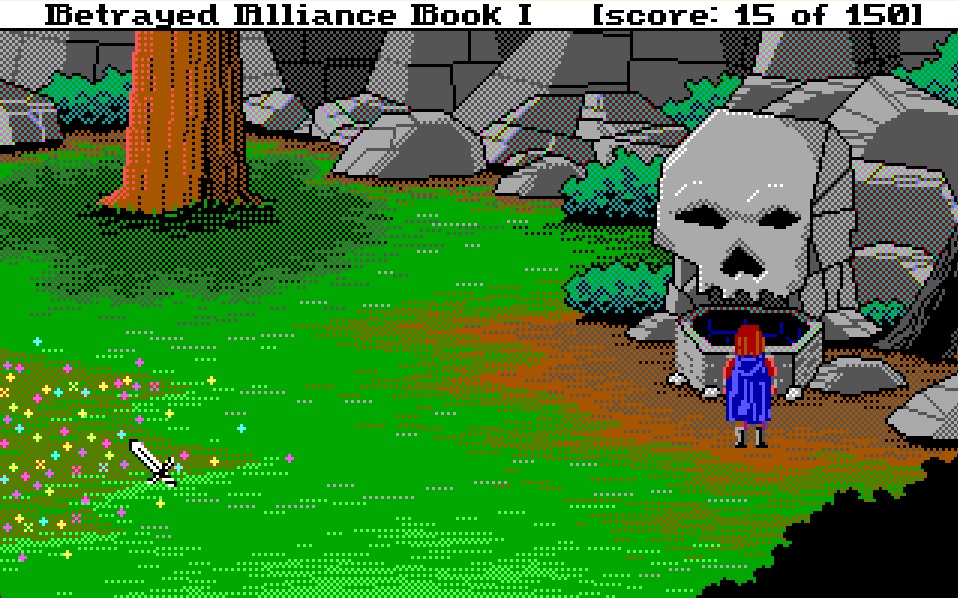


Book 1 now stands ready to launch in May of 2024. The first “launch” was in 2013, and went hidden and unpublicized. It was made for a small community and it didn’t reach far beyond it. I spent a year fixing bugs and adding quality of life features and re-released it in 2020, now with a bit more reach. I say “a bit” in that I didn’t really ask any personalities/reviewers to talk about it. But there were a few people who streamed it on Twitch and a handful of YouTube videos of people playing the game.
The third release, however, feels like a whole different animal. The game is now quite beautiful and much more polished, and best of all, doesn’t have a “heap space” error that crashes the game on at least 10% of playthroughs! Yes, the game is still free and always will be. The whole thing started because when I was 20 I found a program that could make games like I loved when I was a kid. It all comes down to that creative impulse. I just wanted to do it!
So What Now?
Get the game! It’s free! Play it, share it, do whatever with it. Have some old-school fun!

If you want to support me in finishing the series, know this, I am slow! I have a fulltime job and three dependent children! But I work on the project little by little, every day. You can support me via Patreon if this is the kind of stuff you love and you are in a position to.
You can also support the project and get really cool stuff, like the Player’s Guide!
Finally, there are beautiful shirts and hoodies you can get from Fourth Wall:



